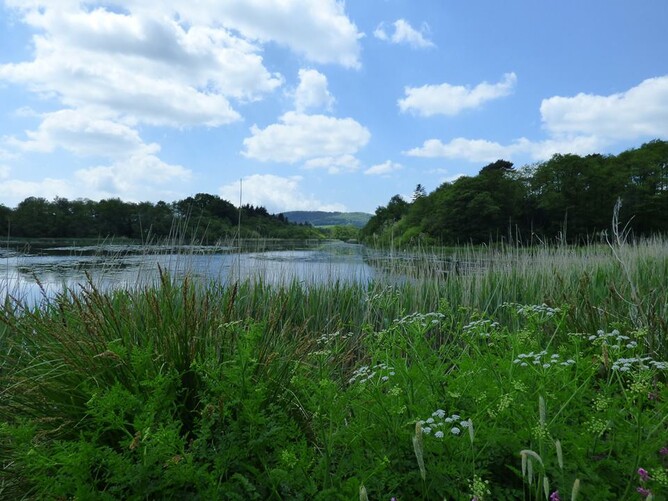A corner of West Sussex’s Lower Weald keeps a secret - a small gem that yields both sporting value and genuine wonder in a modern countryside where such things are increasingly rare. Mike Smith tells us all about it.
Try to find it on a map
Our little flight pond was never meant to remain nameless or secret. We found it that way a decade ago and that just happens to be the way it stayed. Even Ordnance Survey maps appear to pass it by: the little brook that feeds it marked as a slender, meandering blue line; enveloping hedgerows thicken intriguingly and hint at more. That aside, to an outside world made restless by Google inspired curiosity, this vestige of Old Sussex keeps something back.
The pond's farm - a brief history
The farm on which our pond sits would push to a little over 90 acres, its tangled hedgerows and tousled spinneys a night and day anachronism to the larger farms around it. One way or another, and for reasons long forgotten, its outward form has changed little in generations.
From the ramshackle collection of buildings at the farm’s core you might guess at its history as a dairy farm. Of its time it epitomised efficiency: the size of its Dairy Shorthorn herd dictated by the number of animals that could be milked by hand twice a day. In 1863 the Arun Valley railway linked London to Brighton, creating prosperity for Wealden farms supplying breakfast milk to the capital.
Although the Weald was never an intensively ‘keepered’ area, unlike the nearby South Downs with its vast partridge manors, wherever a farm had an interest in shooting there was always enthusiasm. Small, mixed farms working to build soil fertility rotating crops and livestock yielded much incidental value for wildlife. Cropping patterns commonly included spring cereals and winter root crops, offering game of every kind habitat in which to thrive. Farm shoots abounded, and even when a farmer didn’t shoot there was rarely any objection to a keen neighbour ‘putting a few more down’.
Restoring the pond's former glory
Whether the pond contributed to shooting before our tenure it is difficult to say. If it had it would have been long ago, because what we found was utterly derelict. Badly overgrown with a tangle of near-impenetrable willow and blackthorn, it took a month to clear. With sunlight hitting the water for the first time in years it stained molasses-black, choked with silt. Like many farm ponds falling to neglect, it had served as a convenient rubbish pit: another month of clearing and machine dredging.
In cutting back the pond there were clues to its past. Shaped like a ‘pie-slice’ orientated east to west, with its feederbrook entering at its tapering, easterly point this was not a naturally occurring feature: a deliberate banking operation to dam and form a pond had been undertaken across the ‘crust’ at its widest end. A brace of sizeable oaks growing on the long back-slope of the dam-bank and a dozen or more coppiced alders, the stools of which last felt the nip of the woodman’s saw many decades hence, indicated some age.
Thick hedges forming the pond’s longer northern and southern flanks tumble clumsily into hay-meadows, in summer strewn with lilac cuckooflower and thickly veined with buttercups. Field edges wash with an irregular tideline of cow-parsley, foxglove, stitchwort and speedwell, white and red Campion. Our business here is duck, but it is impossible not to feel the presence of this place as it shimmers with colour and life.
The cycle of our sport
Pragmatism steels us to the cycle of our sport, it never seems far from harvest time and another countdown to the season. Yet despite our chores, distractions are commonplace and the wonder of the pond and its surroundings regularly captivates. The spring of year three brought with it the first nightingale, its song pinned to the memory of a warm, mayflower-scented evening. In the tremble of the kestrel’s wings we willingly mislay time, our watching snagged on the hesitating barb of the bird’s heartbeat as it grasps for the chance to crumple earthward.
Mallard have been our mainstay, and as we look back and savour modest success, there nonetheless hangs a question: How could we ever have failed? The pond sits to the easterly edge of the river Arun’s great flood plain. Tidally influenced from the English Channel at Littlehampton upriver 25 miles to Pallingham, the river beats hypnotic in its ‘push-and-pull’ affect on duck. For mallard, not wholly addicted to the brackish ‘fix’ of the salt marsh and at home inland, the stimulus to move resonates deepest of all, reaching well beyond the tide-stirred banks stretching to the high gylls at the river’s source.
Sport gifts us memories, and by the very nature of shooting memories bond themselves to places. The little pond brims with things remembered: friends and friendship, a child’s first guided shot, the grey-muzzled tenderness of an old dog’s last retrieve, the soft splash of duck left to come in at your back as you quit – adrenalin still lapping at the heart; not daring to look back lest the magic is lost.
Time to say goodbye
Yet however much we attach value to places, without outright ownership there is no certainty. We were informed of the farm’s sale at the start of last season, and of the intention to develop. The 2015-16 season was as rich and full as any other, and within long established routine reality could be suspended, even denied. At the turn of the year, however, the surveyor’s markers were dotted around and as we busied preparing blinds for the season’s final flight the persistent and ominous staccato beep of reversing plant drifted in on the breeze.
We could shoot for another year, but by then the hedge-scrubbing bulldozer would be close and the pond inevitably affected. Unable to bear the prospect of that destruction, we opted to say farewell this spring: the pepper-blue shock of late bluebells framing indelibly a last poignant image of the pond.
The developer’s advertising promotes “Modern Village Living”. The more sanguine might hope that the pond continues as a central feature on a new village green, so entering another chapter in its long history. Those more pessimistic would note that the developer’s plans have already placed our precious, nameless and secret place squarely beneath a roundabout.
Enjoyed this article and want to know more?
Why not contact us at Glenzier Sporting. Mike Smith has run the Whithorn shooting ground for 20 years and offers teaching lessons and gun fitting.


